Xero Bundle
Who Really Owns Xero?
Uncover the ownership secrets behind Xero, the global force in cloud accounting. From its humble beginnings in New Zealand to its current status as a publicly traded company, Xero's ownership structure has shaped its destiny. Understanding Xero SWOT Analysis is key to grasping its competitive landscape.
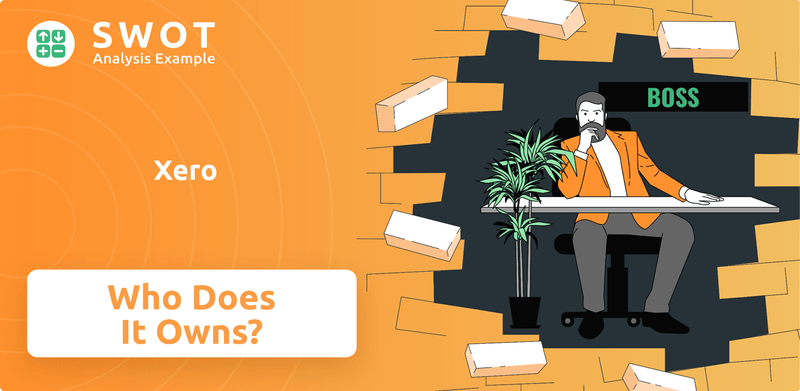
This exploration into Xero's ownership will reveal the key players influencing the Xero company's strategic decisions and financial performance. We'll examine the roles of the Xero founder, major shareholders, and the impact of its IPO. Discovering who owns Xero provides critical insights into the future of this leading Xero accounting software provider.
Who Founded Xero?
The story of Xero's brief history began in 2006 in New Zealand, with a vision to revolutionize accounting. The founders, Rod Drury and Hamish Edwards, set out to create a user-friendly, cloud-based accounting solution. Their initial focus was on small businesses, aiming to disrupt the traditional accounting software market.
The company, originally named Accounting 2.0 Limited, launched with a modest capital injection. This early funding and the founders' strategic direction were crucial in setting the stage for Xero's future growth. The founders' vision was clear: to offer an efficient, cloud-based solution, which would become a significant factor in its success.
Rod Drury, a tech entrepreneur, and Hamish Edwards, an accountant, formed the initial ownership structure. Drury held the majority stake, while Edwards also had a significant share. This early ownership setup reflects the founders' commitment and the initial investment that fueled Xero's early development.
Founded in 2006 by Rod Drury and Hamish Edwards.
Initial capital of $1.5 million.
Rod Drury held 74.3% and Hamish Edwards held 20%.
IPO on the New Zealand Exchange (NZX) on June 5, 2007, with an NZ$15 million IPO.
Initial market capitalization of NZ$55 million.
Rod Drury held a 45% stake and Hamish Edwards held 13% at the IPO.
Xero's journey includes key milestones in its ownership structure and funding rounds. Early on, Hamish Edwards exited the company. Later, the company received funding from various investors. By October 2013, Xero had raised over $230 million, with additional funding from Accel and Matrix Capital by February 2015. Understanding the Xero ownership structure provides insights into the company’s strategic direction. The Xero accounting software has grown significantly since its inception.
- June 2007: Xero went public on the NZX.
- 2009: MYOB founder Craig Winkler led NZ$23 million in funding.
- October 2013: Raised over $230 million from investors.
- February 2015: Received additional funding from Accel and Matrix Capital.
Xero SWOT Analysis
- Complete SWOT Breakdown
- Fully Customizable
- Editable in Excel & Word
- Professional Formatting
- Investor-Ready Format
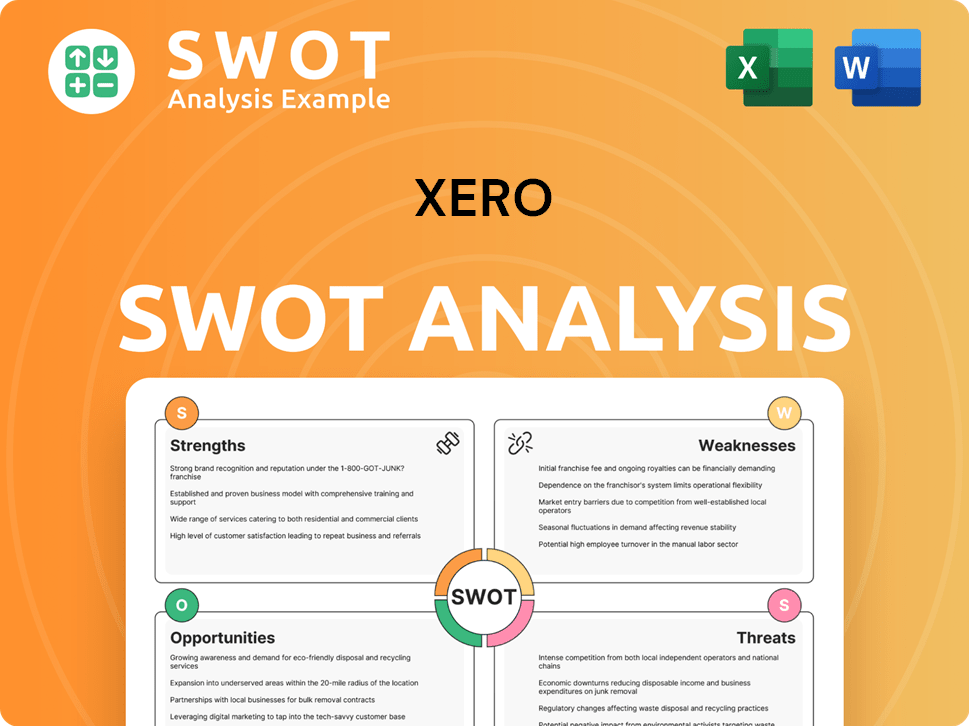
How Has Xero’s Ownership Changed Over Time?
The ownership structure of the Xero company has seen significant changes since its inception. Initially, the company was privately held, but as it grew, it sought public funding and expanded its shareholder base. A pivotal moment was the dual listing on the Australian Securities Exchange (ASX) on November 8, 2012, followed by a transition to a sole listing on the ASX on February 5, 2018, delisting from the NZX on February 2, 2018. This shift to a sole listing on the ASX streamlined its operations and increased its visibility in the financial markets, impacting its ownership dynamics.
The delisting from the NZX in February 2018, when Xero's market capitalization was approximately A$4.5 billion, marked a strategic realignment. The company's value has since grown substantially, reaching A$20.6 billion as of a recent report. These strategic moves, including public listings and delistings, have influenced Xero's strategy, enabling global expansion and increased product offerings.
| Key Event | Date | Impact on Ownership |
|---|---|---|
| Dual Listing on ASX | November 8, 2012 | Expanded shareholder base, increased capital. |
| Sole Listing on ASX, Delisting from NZX | February 5, 2018 / February 2, 2018 | Simplified market presence, strategic realignment. |
| Market Capitalization Growth | Ongoing | Increased investor interest, valuation growth. |
As of October 30, 2024, the ownership of Xero is primarily held by individual investors, who collectively own 59% of the shares. Institutional investors hold 33%, and the top 25 shareholders control 37% of the business. Key institutional shareholders include The Vanguard Group, Inc. with 5.1%, Hyperion Asset Management Limited with 5.0%, and BlackRock, Inc. with 4.1%. As of April 12, 2024, HSBC Custody Nominees (Australia) Limited held 35.24% of issued capital, J P Morgan Nominees Australia Pty Limited held 21.03%, and Citicorp Nominees Pty Limited held 14.83%. Rod Drury, the Xero founder, retains a significant stake, listed as 2.412% as of a recent report.
Xero is a publicly traded company with a diverse shareholder base. Individual investors hold the largest share, with institutional investors also playing a significant role.
- Individual investors hold the majority of shares.
- Institutional investors include The Vanguard Group, Inc. and BlackRock, Inc.
- The founder, Rod Drury, still holds a notable stake.
- The company's market cap is currently around A$20.6 billion.
Xero PESTLE Analysis
- Covers All 6 PESTLE Categories
- No Research Needed – Save Hours of Work
- Built by Experts, Trusted by Consultants
- Instant Download, Ready to Use
- 100% Editable, Fully Customizable
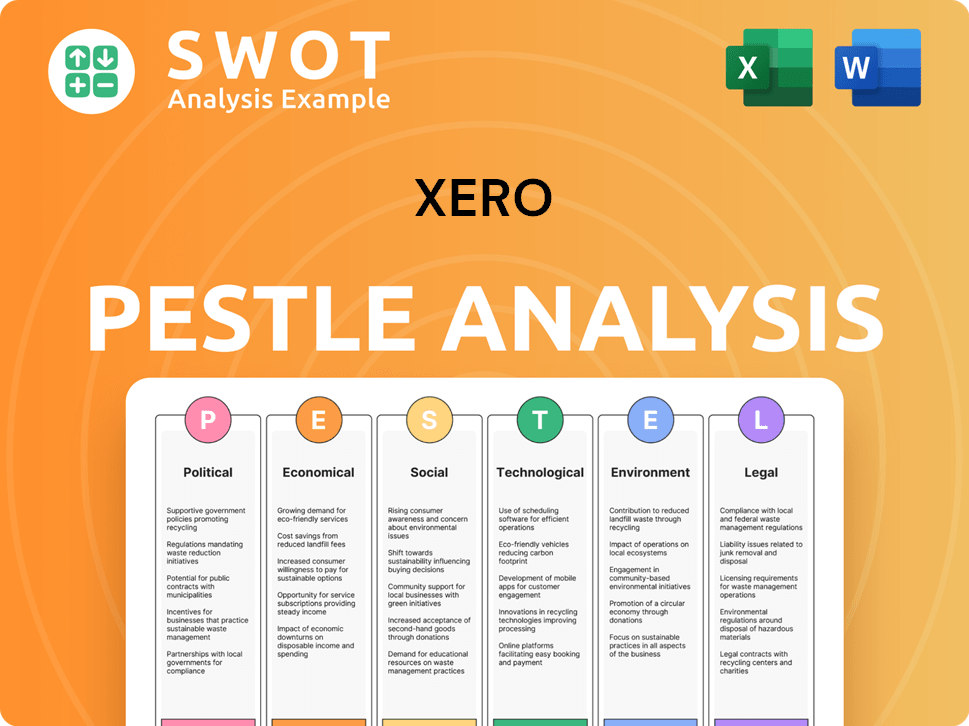
Who Sits on Xero’s Board?
The Board of Directors at Xero, a prominent player in the accounting software industry, is pivotal in overseeing the company's management and operations. As of 2024, David Thodey holds the position of Chair of the Board, providing strategic guidance. Sukhinder Singh Cassidy serves as the CEO, having been appointed in February 2023, succeeding Steve Vamos. Rod Drury, the Xero founder, remained on the board as a non-executive director until 2023, contributing his expertise.
The board's composition and leadership are crucial for navigating the company's strategic direction and ensuring effective governance. The company's evolution, including changes in leadership and board membership, reflects its growth and adaptation to the dynamic market conditions within the accounting software sector. The decisions made by the board significantly influence the company's performance and its ability to compete effectively. Understanding the board's structure and its key members is essential for anyone interested in the Xero company.
| Board Member | Position | Year Joined |
|---|---|---|
| David Thodey | Chair of the Board | N/A |
| Sukhinder Singh Cassidy | CEO | 2023 |
| Rod Drury | Former Non-Executive Director | N/A |
The voting structure for Xero, as a publicly traded entity, generally adheres to a one-share-one-vote principle. Individual investors hold a significant stake, with approximately 59% of the shares as of October 2024, which gives them considerable influence over crucial decisions. This includes matters such as executive compensation, dividend policies, and potential acquisitions. The company's focus on robust corporate governance is evident in its approach to investor relations, especially as a mature global business. Xero's commitment to good governance is further demonstrated by submitting its remuneration report as an advisory resolution to shareholders at its Annual Meeting.
The Board of Directors at Xero oversees the company's management and operations, playing a crucial role in its governance. Sukhinder Singh Cassidy is the current CEO. The voting structure generally operates on a one-share-one-vote basis.
- David Thodey is the Chair of the Board.
- Sukhinder Singh Cassidy became CEO in February 2023.
- Individual investors hold a significant portion of shares.
- The company focuses on robust corporate governance.
Xero Business Model Canvas
- Complete 9-Block Business Model Canvas
- Effortlessly Communicate Your Business Strategy
- Investor-Ready BMC Format
- 100% Editable and Customizable
- Clear and Structured Layout
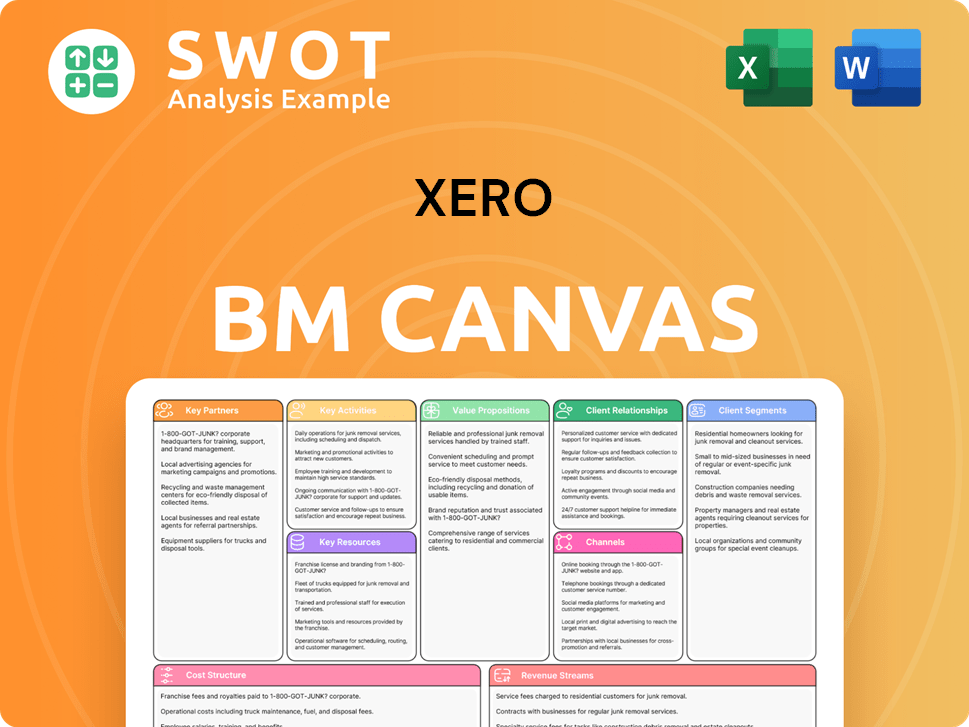
What Recent Changes Have Shaped Xero’s Ownership Landscape?
Over the past few years, the ownership and strategic direction of the Xero company have seen notable shifts. The company demonstrated robust financial performance in FY24, with operating revenue reaching NZ$1.7 billion, a 22% increase, and a substantial 83% surge in net profit to NZ$174.6 million. This positive trend continued into FY25, with revenue growing by 23% to NZ$2.1 billion and a 48% increase in free cash flow, reaching NZ$506.7 million. This financial success underscores the company's focus on balancing growth with profitability, a strategic goal outlined in early 2024.
Xero has also been actively adjusting its subscription plans and pricing strategies. In September 2024, new plans such as Xero Ignite, Grow, and Comprehensive were introduced, replacing older plans. Existing customers are being gradually transitioned to these new plans, potentially leading to price adjustments for some. Leadership changes, including Sukhinder Singh Cassidy becoming CEO in February 2023, have further influenced the company's direction, with a greater emphasis on profitability. These changes have contributed to an increase in average revenue per user (ARPU), which has grown by 50% since 2022.
| Metric | FY24 (Year Ended March 31, 2024) | FY25 (Year Ended March 31, 2025) |
|---|---|---|
| Operating Revenue | NZ$1.7 billion (+22%) | NZ$2.1 billion (+23%) |
| Net Profit | NZ$174.6 million (+83%) | N/A |
| Free Cash Flow | N/A | NZ$506.7 million (+48%) |
The ownership structure of Xero is also evolving, with increased institutional ownership becoming evident. As of October 2024, individual investors held the majority, at 59%, but institutional ownership accounted for a significant 33%. The company continues to foster strategic partnerships, such as with BILL and Deputy, to enhance its service offerings and market presence. Xero's aspiration is to double its business size while maintaining a 'Rule of 40' performance, aiming for a combined annual revenue growth percentage and free cash flow margin percentage of 40% or higher.
The shift in Xero ownership shows a growing institutional presence. The company is focused on profitability and strategic partnerships. Financial performance reflects strong revenue and profit growth.
Xero has formed key alliances, like the one with BILL. These partnerships aim to improve its service offerings. The investment in Deputy is another example of strategic moves.
Xero's financial results highlight its strong growth. Revenue and profit margins have seen significant increases. The company is focused on achieving sustainable growth.
Sukhinder Singh Cassidy's leadership has been pivotal. The company is prioritizing profitability alongside expansion. Pricing adjustments are part of the strategic shift.
Xero Porter's Five Forces Analysis
- Covers All 5 Competitive Forces in Detail
- Structured for Consultants, Students, and Founders
- 100% Editable in Microsoft Word & Excel
- Instant Digital Download – Use Immediately
- Compatible with Mac & PC – Fully Unlocked
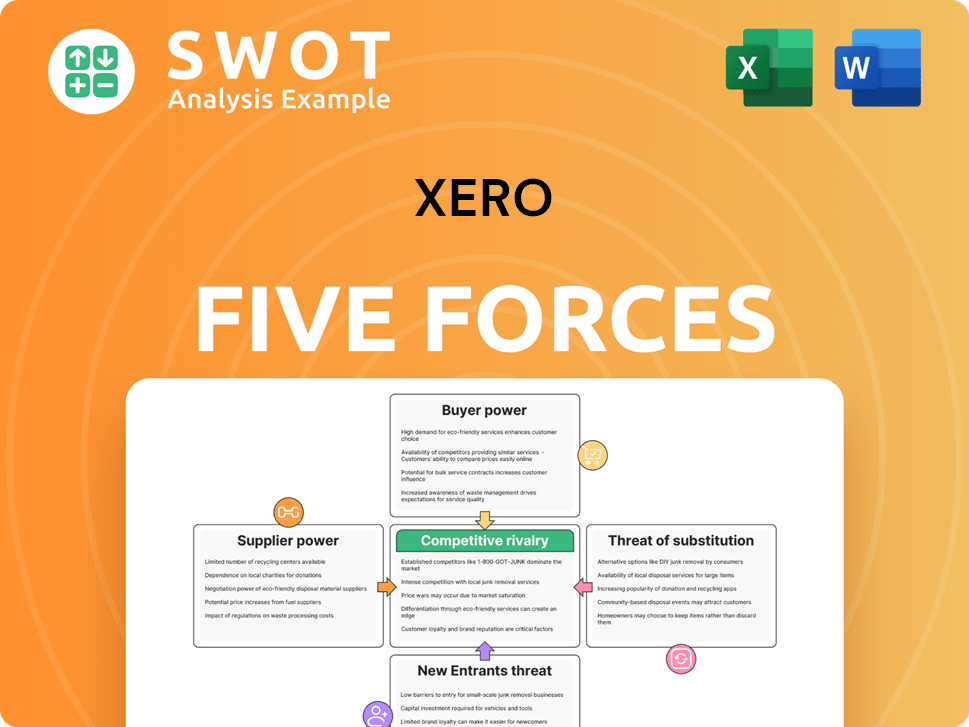
Related Blogs
- What are Mission Vision & Core Values of Xero Company?
- What is Competitive Landscape of Xero Company?
- What is Growth Strategy and Future Prospects of Xero Company?
- How Does Xero Company Work?
- What is Sales and Marketing Strategy of Xero Company?
- What is Brief History of Xero Company?
- What is Customer Demographics and Target Market of Xero Company?
Disclaimer
All information, articles, and product details provided on this website are for general informational and educational purposes only. We do not claim any ownership over, nor do we intend to infringe upon, any trademarks, copyrights, logos, brand names, or other intellectual property mentioned or depicted on this site. Such intellectual property remains the property of its respective owners, and any references here are made solely for identification or informational purposes, without implying any affiliation, endorsement, or partnership.
We make no representations or warranties, express or implied, regarding the accuracy, completeness, or suitability of any content or products presented. Nothing on this website should be construed as legal, tax, investment, financial, medical, or other professional advice. In addition, no part of this site—including articles or product references—constitutes a solicitation, recommendation, endorsement, advertisement, or offer to buy or sell any securities, franchises, or other financial instruments, particularly in jurisdictions where such activity would be unlawful.
All content is of a general nature and may not address the specific circumstances of any individual or entity. It is not a substitute for professional advice or services. Any actions you take based on the information provided here are strictly at your own risk. You accept full responsibility for any decisions or outcomes arising from your use of this website and agree to release us from any liability in connection with your use of, or reliance upon, the content or products found herein.